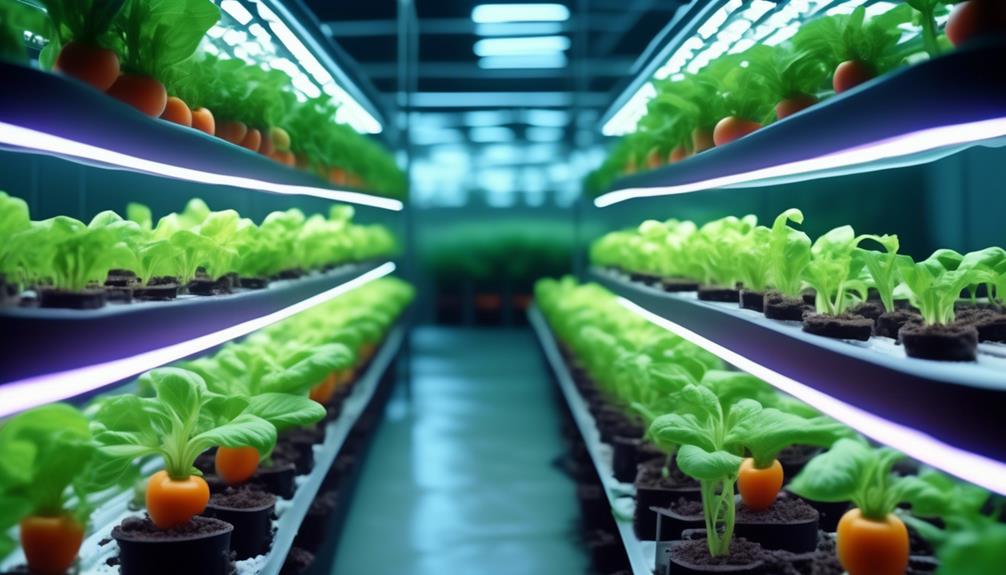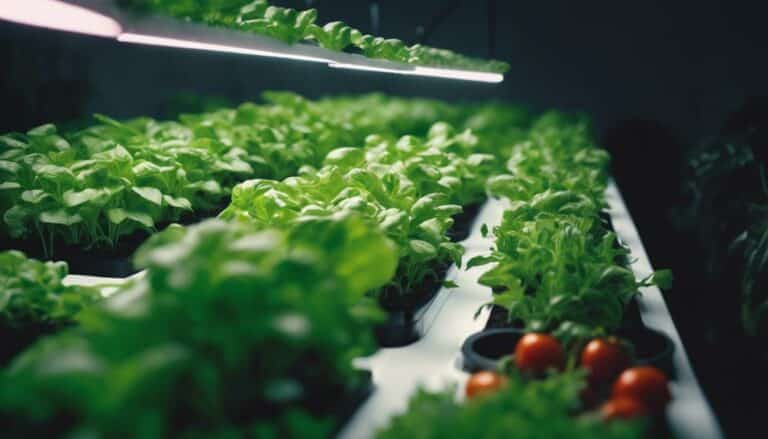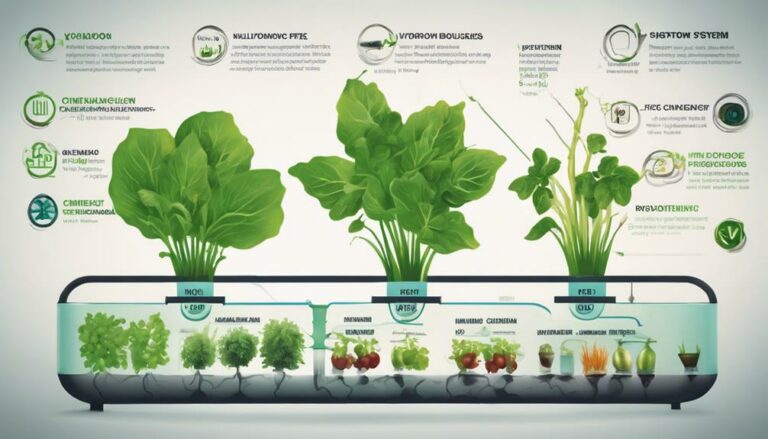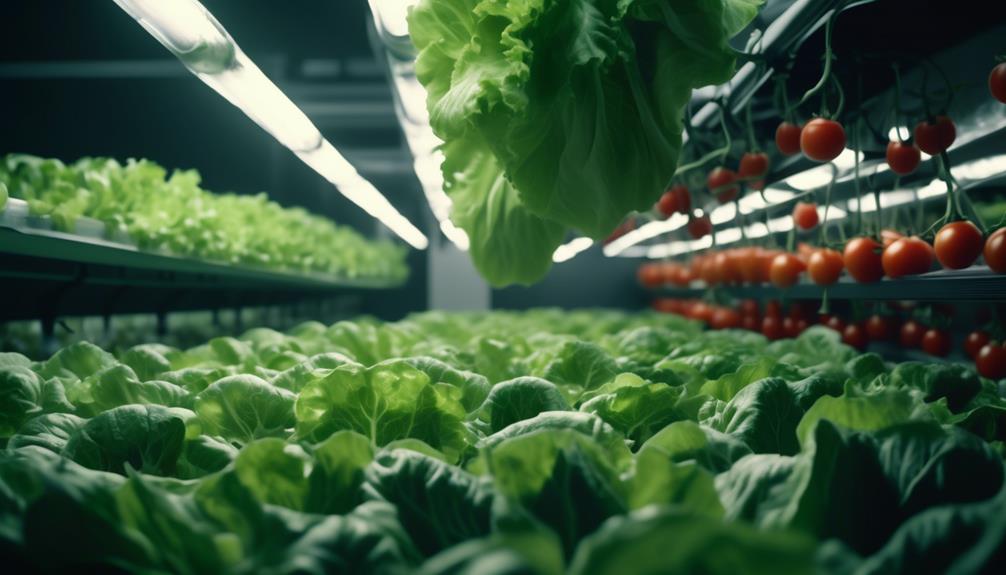Nearly 50% of hydroponic growers report higher yields compared to traditional soil gardening, making it an increasingly attractive method for cultivating crops. We’ve seen firsthand how the right selection of plants can lead to exceptionally abundant harvests.
Table of Contents
Leafy greens, such as lettuce and spinach, thrive in these soil-less systems due to their shallow roots and quick growth cycles, but there’s a broad spectrum of fruits, vegetables, and herbs that can also flourish with the precise nutrient management hydroponics provides. Yet, not all crops are equally suited for hydroponic success; the choice of plants must align with the specific system and environmental conditions in place.
As we explore the perfect crops for hydroponic setups, we’ll consider factors such as growth requirements, system compatibility, and market demand to help you maximize your harvest potential.
Stay with us as we uncover the keys to a bountiful hydroponic garden that could transform not only your cultivation practices but also your yield outcomes.
Assessing Crop Suitability
To maximize yield and efficiency in hydroponic systems, it’s crucial to carefully assess which crops are best suited to this soilless farming method. We consider various factors, such as the specific nutrient needs of potential crops for hydroponic cultivation, to ensure that the plant growth thrives in a controlled environment. Different plants require distinct nutrient profiles and levels of electrical conductivity—a measure of the nutrient solution’s ability to conduct electricity, which correlates to its nutrient content.
When we select crops, we prioritize those with similar nutrient needs and growth cycles. This strategy allows us to streamline our nutrient delivery systems and avoid complications arising from disparate requirements. Leafy greens like lettuce and herbs are often ideal candidates, as they adapt well to hydroponic systems and have relatively simple nutrient requirements. These crops also mature quickly, providing fast returns on our investment.
Moreover, we monitor the electrical conductivity closely to maintain optimal levels for our chosen crops. By doing so, we prevent nutrient imbalances that could hinder plant growth or reduce yield.
Through careful assessment and management, we’re able to create a system that’s both innovative and productive, delivering abundant harvests from our hydroponic endeavors.
Leafy Greens: Optimal Choices
Turning our attention to leafy greens, we’ll explore the most popular varieties that promise success in hydroponic systems.
We’ll also share insights on the specific nutrient requirements essential for cultivating lush, healthy greens.
Lastly, we’ll offer practical harvesting tips to ensure you get the most from your leafy green crops, from spinach to microgreens.
Popular Leafy Green Varieties
When selecting leafy greens for hydroponic systems, lettuce, spinach, and kale stand out as top choices due to their ease of growth, nutritional benefits, and adaptability to controlled environments. We’ve discovered that these greens thrive under LED grow lights, responding well to the consistent application of nutrient solutions. Their fast growth ensures a quick turnover, which is ideal for our hydroponic gardening pursuits.
To highlight the top performers in hydroponic systems, consider these varieties:
- Romaine and Butterhead Lettuce: Known for their crisp texture and rapid development.
- Savoy Spinach: Offers a robust flavor and is packed with vitamins.
- Curly Kale: Provides a hearty leaf structure, ideal for nutrient-rich salads.
- Swiss Chard: Stands out with its vibrant stems and versatile use in culinary creations.
Nutrient Requirements for Greens
Leafy greens like lettuce, spinach, and kale require precise nutrient solutions in hydroponic systems to achieve their full growth potential and yield abundant harvests. These plants need a nutrient-rich solution tailored to their specific needs, which is why grouping plants with similar nutrient profiles can be highly efficient.
In our hydroponic setups, we ensure the delivery of a balanced mix of essential elements, fostering healthy development and rapid growth.
Harvesting Tips: Leafy Greens
Having established the nutrient requirements for thriving leafy greens, we’ll now focus on the best practices for harvesting these hydroponic crops to ensure peak freshness and flavor.
Here are our top harvesting tips:
- Monitor Growth Cycles: Harvest leafy greens when they’re young for optimal flavor. Plants grow faster in hydroponic gardens, so keep an eye on their progress.
- Harvest in Mornings: The cooler temperatures ensure leaves are crisp and full of moisture.
- Use Clean Cuts: Sharpened blades prevent damage to the plants, promoting regrowth.
- Thin Seedlings: This overlooked step ensures adequate space and nutrients for the remaining plants, leading to healthier, fuller leafy greens.
Fruit-Bearing Plants Considerations
As we turn our attention to fruit-bearing plants in hydroponics, we must consider their unique demands to achieve optimal growth.
We’ll explore how precise nutrient formulations and adequate light exposure are critical for the development of fruits like tomatoes and strawberries.
Additionally, we’ll examine strategies for ensuring effective pollination within the controlled environment of a hydroponic system.
Optimal Nutrient Requirements
To secure bountiful yields, we must tailor hydroponic nutrient solutions to the specific stages of growth and fruiting in plants. Our systems enable the precise delivery of nutrients, ensuring plants grow vibrantly and produce abundantly.
Here’s what we focus on:
- Balanced Nutrient Solutions: Every stage of plant growth demands a unique nutrient mix.
- Adjusting Nutrient Needs: As fruit-bearing plants mature, their nutrient requirements shift—requiring us to adapt.
- Monitoring pH Levels: We’re meticulous about pH to guarantee optimal nutrient uptake.
- Addressing Deficiencies: Spotting and correcting nutrient shortages is straightforward in our hydroponic setups.
We’re committed to innovating the way we grow, ensuring every plant receives the ideal nutrient blend for spectacular results.
Light Exposure Necessities
While we’ve ensured that our plants are nourished with the perfect blend of nutrients, we must also focus on providing them with the proper light exposure to promote healthy growth and abundant fruiting. Our fruit-bearing hydroponic plants have differing light requirements—some crave intense beams, while others fare better with a gentler touch. It’s not just about intensity; duration matters too. We’re keen on striking the right balance to spur on flowering and fruiting.
Grow lights, particularly LED Grow options, have revolutionized how we manage light exposure. These innovations let’s simulate natural sunlight, tailor light cycles, and keep a close watch on light levels, ensuring our crops receive exactly what they need. By meticulously monitoring and adjusting our lighting setups, we’re setting our plants to grow prolifically and produce bountiful harvests.
Pollination in Hydroponics
Ensuring successful pollination within our hydroponic system is a critical step towards achieving a plentiful yield of fruit. As we foster growth in our plants without soil, we must consider how best to encourage fruit development in a controlled environment.
Here’s what we do:
- Manually pollinate fruit-bearing plants using a small brush, mimicking the action of pollinators.
- Introduce bees or install fans to simulate natural air movement for plants that benefit from such methods.
- Recognize self-pollinating plants like tomatoes that may not require our intervention.
- Study each plant’s specific pollination needs to tailor our approach for abundant harvests.
Herbs for Hydroponic Growth
Growing herbs like basil, mint, and cilantro hydroponically offers gardeners a compact and efficient way to produce these high-demand culinary and medicinal plants year-round. By embracing this method of growing plants, we can bypass the limitations of traditional soil-based cultivation and enjoy a steady supply of fresh herbs.
We’ve found that a DWC hydroponic system can be particularly effective for these herbs. Basil thrives with daily pruning and warm temperatures, which are easily maintained in a controlled hydroponic environment. Mint, with its vigorous growth, also excels in hydroponic systems, and can be kept in check to prevent it from overtaking other plants.
Our experience shows that chives, typically grown in vertical towers, adapt beautifully to hydroponic setups. They require less space and provide continuous harvests when given enough light. Systems can support chives year-round, making them a practical choice for those seeking innovation in their herb production.
Moreover, coriander, another herb easily grown hydroponically, confirms our belief in the efficiency of hydroponics. It yields steadily and occupies minimal space, proving that herbs grown hydroponically aren’t just feasible but also a smart, space-saving solution for continuous cultivation.
Root Vegetables in Hydroponics
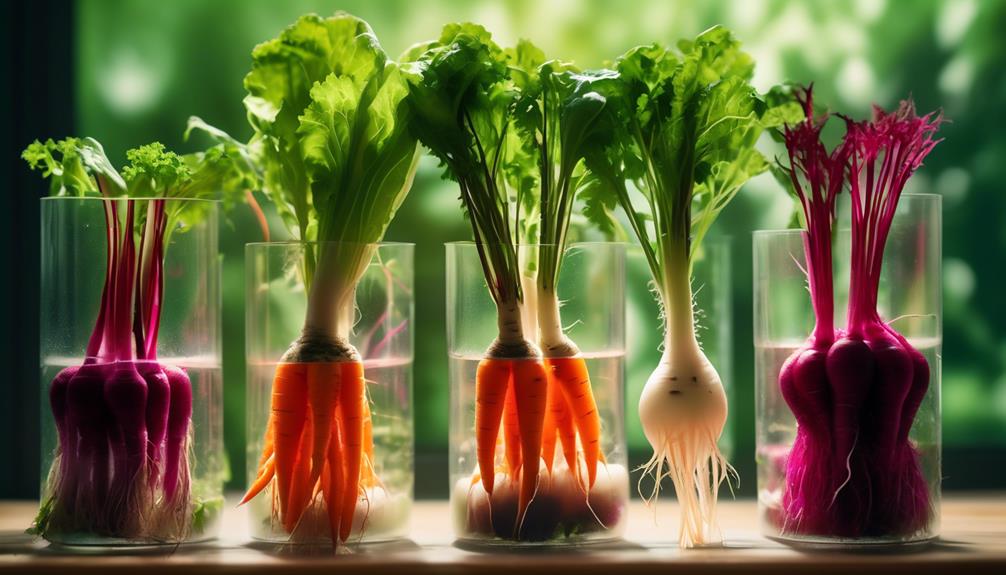
Root vegetables such as carrots, beets, and radishes can flourish in hydroponic gardens, provided they’ve ample space and the right support systems in place. When we grow these plants hydroponically, we overcome the limitations of poor soil quality and can achieve remarkably clean, large roots.
Let’s focus on four key aspects to ensure success:
- Adequate Space: Our hydroponic system must allow for the expansion of the large root. We design our setups with enough depth and width to accommodate growth.
- Proper Medium: We choose growth media that support the plant while allowing roots to penetrate and expand effortlessly, like coconut coir or perlite.
- Nutrient Balance: We pay close attention to our nutrient solutions, ensuring they’re tailored to root vegetables’ needs, providing all the essential elements for robust growth.
- Environmental Control: We constantly monitor and adjust water temperature, pH levels, and nutrient concentrations in our Water Culture (DWC) systems to maintain optimal conditions for our plants.
Flowering Plants Selection
Selecting the right flowering plants for hydroponic systems is crucial for both aesthetic appeal and fruitful harvests. When we focus on flowering plants selection, we’re aiming for species that offer high yields and vibrant blooms. In our hydroponic setup, we’ve discovered that certain flowering plants not only beautify the space but also grow faster and more robustly than their soil-grown counterparts.
For those of us seeking to innovate and push the boundaries of traditional gardening, hydroponically grown plants present an exciting opportunity. Flowering plants such as tomatoes, strawberries, and peppers thrive in these systems, producing abundant and flavorful fruits. The precise control of nutrients and environmental conditions in a hydroponic setup means these flowering crops can outperform those grown in conventional gardens.
As we consider our flowering plants selection, we’re also mindful of the specific requirements of each species. We ensure that our hydroponic system accommodates the spatial needs of larger blooms, while also providing the right light and nutrient mix for each type of plant. By doing so, we can enjoy a diverse array of grown plants that not only look stunning but also contribute to a bountiful harvest.
Managing Hydroponic Crop Rotation
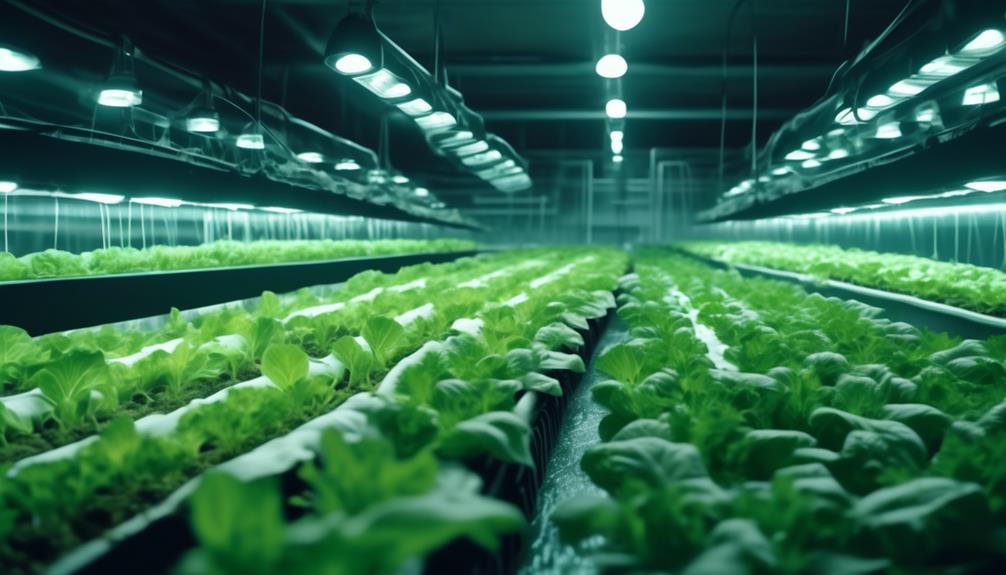
We’ll optimize our harvests by implementing a strategic crop rotation plan within our hydroponic system, ensuring each plant variety receives the attention it needs at the right time. In the world of hydroponic farming, it’s crucial to manage crop rotation meticulously to maintain a continuous supply of fresh produce.
Let’s grow together by following these key steps:
- Succession Planting: Stagger the planting of crops to ensure a constant harvest. For instance, start new lettuce seeds every two weeks.
- Crop Diversity: Introduce a variety of small plants that have similar growth rates and nutritional needs to make sure they thrive together.
- Disease Prevention: Regularly rotate crops to different areas of the system to prevent the buildup of plant-specific pathogens.
- Nutrient Film Technique (NFT) Adaptation: Utilize the NFT system for leafy greens and herbs, rotating them out after harvest, and replacing with new seedlings.
Frequently Asked Questions
What Are the Best Crops for Hydroponic Farming?
We’ve found that leafy greens and herbs excel in hydroponic systems, thanks to careful nutrient management, space-saving setups, and optimized lighting. Seasonal growth patterns and water quality are crucial for their success.
Which Crops Are Most Commonly Harvested Using Hydroponics and Why?
We’ve found that leafy greens, herbs, tomatoes, cucumbers, and strawberries are top hydroponic crops due to advanced environmental control systems, effective pest control strategies, and meticulous nutrient solution management ensuring water purification importance is upheld.
What Are the 5 Best Type of Plants Grown in Hydroponic Systems?
We’ve found that lettuce, basil, tomatoes, cucumbers, and strawberries excel in hydroponics, thanks to superior nutrient management, fast growth rates, efficient space use, and smart seasonal planning and crop rotation strategies.
What Is the Most Effective Hydroponic Method?
We’re navigating the sea of hydroponics, finding that the most effective method balances nutrient solution optimization, precise climate control, and efficient lighting setups, with thoughtful growth medium choices steering our course to bountiful yields.

